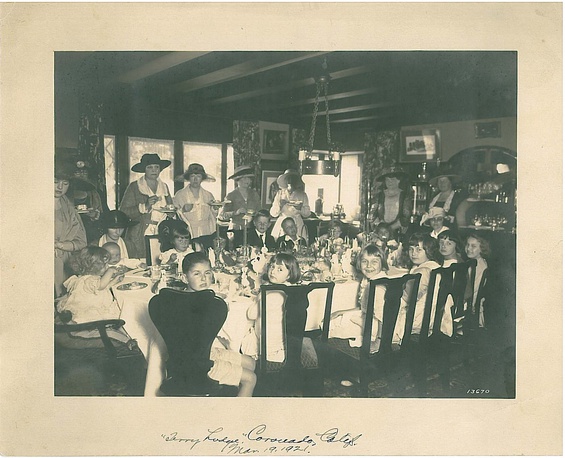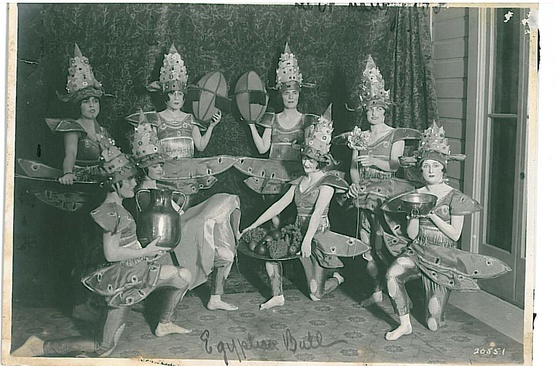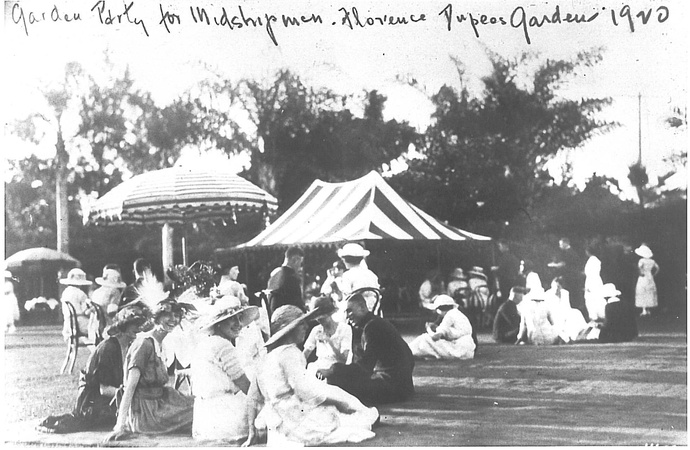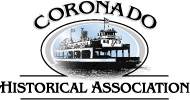Coronadans Knew How to Party
By June MacLeod, CHA Volunteer
In glancing through the Coronado Journal and Eagle newspapers from the past decades, it is apparent that the island was the venue for wonderful parties and social events. Over the span of years, Coronado’s citizens and visitors had active social lives and the readers, through the newspaper articles, had a glimpse of what social life was like back then. Some of the parties were simple, but some were on a more grandiose scale.
For example, on August 30, 1912, Mrs. W.D.K. Gibeon of San Francisco and Miss O’Brien, who were staying at the Hotel Del for the summer, hosted an afternoon tea and bridge party at the hotel. The event was held in the hotel’s card room and the tables were decorated with lavender trumpet vine. Tea was served at 5 pm. Many of the social elite were in attendance including Mrs. John D. Spreckels (wife of the owner of the Hotel Del). However, in the same edition there was mention of another bridge and tea party. This time, the party was hosted by Mrs. Claus Spreckels (John D. Spreckels’s mother) and was held aboard a huge yacht named “Venetia”. A description of the event is as follows: “The tables and cabin were decorated in red, white and blue flowers. Cards followed the luncheon, and dainty French pictures were the prizes at each table. Tea was served at four.”

In the October 18, 1912 paper, there was another entry for Mrs. John D. Spreckels. She had a bridge party at her lovely home in honor of Mrs. Carlton Chapman. The story goes on to describe the floral arrangements (“Beautiful chrysanthemums from the Spreckels garden were arranged artistically for the occasion”) and the “dainty prizes” at each table. With a little imagination, you can imagine what the scene looked like.
Not all events went without a hitch. The December 29, 1913 Journal issue mentioned Mrs. John D. Spreckels was getting ready to host a dinner party for “visiting notables”. The family butler went to open the fire and burglar proof safe to get the “family plate”, but the safe would not open. After many furtive attempts, an expert was called in and, “after twirling the dial a few times, he had the doors open, and the day was saved.”
Not all events were happy; some events had a more serious tone. At the close of the first world war, there was an advertisement in the September 6, 1919 Journal announcing a reception for the returning Coronado servicemen from the war. This reception would be held on September 8 at the Silver Strand Theatre and John D. Spreckels would hand out medals to each serviceman. All former service personnel from all wars were encouraged to wear their uniforms. Senator Sample would give the speech and refreshments were handled by the American Red Cross.
Touted as “one of the most brilliant affairs of the season” where “society is all agog” was the Egyptian Ball held at the Hotel Del in March 1924. It was during the 1920s that anything Egyptian was considered all the rage! As the newspaper stated, “Lavish settings and spectacular entertainments are promised and this event is expected to be something absolutely unique and “different”. There will be prizes given, for which everyone in costume will have an oportunity (sp) to compete.” Two of the twelve costume judges were Mr. and Mrs. Cornelius Vanderbilt from Los Angeles who were visiting at the Hotel Del.

Coronado being a Navy town, there were many parties held for the military. In March of 1925, the headline read “Brilliant Affair for Fourteen Admirals”. On March 18, “one of the most brilliant social events of many years” took place. Rear Admiral Ashley Robertson and his wife hosted fourteen admirals at a formal dinner in the Silver Grill of the Hotel Del. Over one hundred guests were invited, including prominent members of the service and civilian society both from Coronado and San Diego. The dinner was preceded by an elaborate reception at the Bachelor’s Office Quarters at North Island. The reception included over one thousand attendees, with two bands playing. The article described the decorations and some of those attending this affair. You can almost imagine the pressed dress uniforms and lovely evening gowns that the attendees wore to these celebrations.
In July 1937, society leaders planned a week of events in celebration of Coronado’s Tenth Annual National Horse Show. The show’s exhibitors were hosted to a party at the “turquoise” pool at the Hotel Del. Mrs. Paul Wegeforth (her husband was a surgeon and a co-founder of the San Diego Zoo) hosted a cocktail party and buffet supper on the terrace of her home. According to the article, Mrs. Wegeforth “will compliment exhibitors, committee members, trophy fund donors, local exhibitors and trainers.” During the week, the Snyders entertained the exhibitors at another party at their Alameda Boulevard home and at the end of the weeklong celebration and performances, there was a dinner dance in the ballroom of the Hotel Del to which the public was invited.
There was an event in 1940 that was open to the public. The June 6, 1940 issue wrote about an old-fashioned box lunch social where men were to bid on the boxed lunches. Sponsored by the Susannah Wesley club, it was held in the Masonic Lodge. The instructions were detailed: “Each lunch box should contain food for two, paper cups and spoons and forks if needed. Coffee will be provided by the Club. Approved garb for the occasion is gingham dresses for the ladies and old clothes for the men. The Piney Ridge male quartet will be one of the features of the entertainment and the guests will be asked to join in a community sing under leadership of Frank Ahrens. There will be an old-fashioned spelling bee, such well remembered games as “musical chairs”, darts and “inside the horseshoe”. In addition it is planned to have music for dancing. There will be prizes for the best decorated box, the best looking girl and handsomest man.” I wonder how well this event was attended.
Before World War II, there were dance parties arranged for the servicemen. One mentioned in the March 6, 1941 issue was the first in a series of dance parties which was held at a home at 1037 Encino Row for young navy and civilian juniors. Two formal dances were a part of that series, directed by Mrs. Charles Kendall, who had majored in dancing.
Then, in the December 11, 1941 paper, Coronado’s social life came to a halt as America became involved in World War II. “Grave happenings these days!—and Coronado social life reflects the extreme conditions as do all other forms of American living—the seriousness of today’s war situation has occassioned (sp) a “wholesale” cancellation of social affairs, club meetings and holiday plans of numerous organizations.
However, during the war years, events continued in Coronado, trying to maintain a sense of normalcy. In the July 13, 1944 issue, several informal parties had been given for a Mrs. A. B. Owens who was visiting Coronado, including a dinner for nine at the Hotel Del and a party at the Officers Club at North Island. Mrs. Owens must have been a distinguished personage to warrant so many parties.
Then, good news: the war was over! It was time to celebrate. The September 20, 1945 edition described the upcoming Victory Ball to be held at the Hotel Del Coronado. The Tau Omicron Phi sorority was presenting its first post-war social event to be held on September 27th. Proceeds were to be given to Navy Relief. “Plans for the Victory Ball which will be the first of its kind in Coronado since the signing of the peace on Sept. 2.” The Tau Omicron Phi sorority was a national service group consisting of daughters of officers of all branches of the military. In addition to the sorority, the ball was sponsored by leading members of the armed forces and the community “that has made an all out effort toward the great day of Victory.”
In the earlier days of Coronado, the island was a playground for the rich and famous. Social events were numerous among those who had the wealth and time to entertain in grand style. However, Coronado was also a patriotic military town and many events were arranged for servicemen like dances at the Hotel Del or garden parties at various homes. Things took a more somber tune during the war years and many large galas were curtailed, but it’s fun to look back on all the parties that this little town has seen over the decades.

